| Revision as of 17:55, 7 December 2002 editAndre Engels (talk | contribs)Extended confirmed users, Pending changes reviewers20,763 editsmNo edit summary← Previous edit | Latest revision as of 23:14, 20 October 2024 edit undoJohnbod (talk | contribs)Autopatrolled, Extended confirmed users, IP block exemptions, Rollbackers280,789 edits →National variations: lk | ||
| (464 intermediate revisions by more than 100 users not shown) | |||
| Line 1: | Line 1: | ||
| {{Short description|European art from about 1590 to 1750}} | |||
| The ] of ] has often been identified with the that of ] and the ], though the existence of important Baroque art and architecture in non-absolutist and Protestant states undercuts this unity. | |||
| {{more citations needed|date=February 2019}} | |||
| ]'' (1599–1600), by ]. ], ], ]. The beam of light, which enters the picture from the direction of a real window, expresses in the blink of an eye the conversion of St Matthew, the hinge on which his destiny will turn, with no flying angels, parting clouds or other artifacts.]] | |||
| ], '']'' or ''The Militia Company of Captain Frans Banning Cocq'', 1642, oil on canvas, {{convert|363|x|437|cm|in|abbr=on}}, ], ]. The painting is a classic example of Baroque art.]] | |||
| ], ''] and ]'' (c. 1605–1607)]] | |||
| '''Baroque painting''' is the ] associated with the ] ]. The movement is often identified with ], the ] and Catholic Revival,<ref name=ebo>, from '']'', latest edition, full-article.</ref><ref> {{webarchive|url=https://web.archive.org/web/20081211173809/http://www.bartleby.com/65/co/CounterR.html |date=2008-12-11 }}, from '']'', Sixth Edition. 2001–05.</ref> but the existence of important Baroque art and ] in non-absolutist and ] states throughout Western Europe underscores its widespread popularity.<ref>Helen Gardner, Fred S. Kleiner, and Christin J. Mamiya, "Gardner's Art Through the Ages" (Belmont, California: ], 2005)</ref> | |||
| === Painting === | |||
| Baroque painting encompasses a great range of styles, as most important and major painting during the period beginning around 1600 and continuing throughout the 17th century, and into the early 18th century is identified today as ] painting. In its most typical manifestations, Baroque art is characterized by great drama, rich, deep colour, and intense light and dark shadows, but the ] of French Baroque painters like ] and Dutch ] such as ] are also covered by the term, at least in English.<ref>For example, in French calling Poussin Baroque would be generally rejected</ref> As opposed to ], which usually showed the moment before an event took place, Baroque artists chose the most dramatic point, the moment when the action was occurring: ], working in the ], shows his ] composed and still before he battles ]; ]'s Baroque ] is caught in the act of hurling the stone at the giant. Baroque art was meant to evoke emotion and passion instead of the calm rationality that had been prized during the Renaissance. | |||
| The ] (1545-63), in which the ] answered many questions of internal reform raised by ] and those who remained inside the Catholic Church, addressed the representational arts by demanding that paintings and sculptures in church contexts should speak to the illiterate rather than to the well-informed. This turn toward a populist conception of the function of ecclesiastical art is seen by many ] as driving the innovations of ] and the ] brothers, all of whom were working (and competing for commissions) in Rome around 1600. | |||
| Among the greatest painters of the ] period are ], ],<ref>{{cite web|url=http://www.getty.edu/vow/ULANFullDisplay?find=Caravaggio&role=&nation=&prev_page=1&subjectid=500115312 |title=Getty profile, including variant spellings of the artist's name |publisher=Getty.edu |date=2002-12-11 |access-date=2012-02-13}}</ref> ],<ref name="Gombrich, p. 420">Gombrich, p. 420.</ref> ],<ref>Belkin (1998): 11–18.</ref> ],<ref>His ''Lives of the Painters'' was published in Rome, 1672. Poussin's other contemporary biographer was ].</ref> and ].<ref>W. Liedtke (2007) Dutch Paintings in the Metropolitan Museum of Art, p. 867.</ref> Caravaggio is an heir of the ] painting of the ]. His ] approach to the human figure, painted directly from life and dramatically spotlit against a dark background, shocked his contemporaries and opened a new chapter in the history of painting. Baroque painting often dramatizes scenes using ] light effects; this can be seen in works by Rembrandt, Vermeer, ] and ]. | |||
| === Sculpture === | |||
| The Flemish painter ] developed a graceful but imposing portrait style that was very influential, especially in England. | |||
| The prosperity of 17th century Holland led to an enormous production of art by large numbers of painters who were mostly highly specialized and painted only ], ], ]s, ]s or ]s. Technical standards were very high, and ] established a new repertoire of subjects that was very influential until the arrival of ]. | |||
| The most important sculptor of the Baroque period is undoubtedly ] (1598-1680), who approached Michelangelo in his omnicompetence. Bernini sculpted, worked as an architect, painted, wrote plays, and staged spectacles. In the late 20th century Bernini was most valued for his sculpture, both for his virtuosity in carving marble and his ability to create figures that combine the physical and the spiritual. He was also a fine portraitist in high demand among the powerful for bust-length likenesses. | |||
| == History == | |||
| === the total work of art === | |||
| ] by ], 1669, ], ]]] | |||
| The ] (1545–1563), in which the ] answered many questions of internal reform raised by both ] and by those who had remained inside the Catholic Church, ] in a short and somewhat oblique passage in its decrees. This was subsequently interpreted and expounded by a number of clerical authors like ], who demanded that ]s and ]s in church contexts should depict their subjects clearly and powerfully, and with decorum, without the stylistic airs of ]. | |||
| This return toward a ] conception of the function of ecclesiastical art is seen by many ] as driving the innovations of ] and the ] brothers, all of whom were working (and competing for commissions) in Rome around 1600, although unlike the Carracci, Caravaggio persistently was criticised for lack of decorum in his work. | |||
| However, although ], ], ], and ] were still considered the most noble subjects, ], ], and genre scenes were also becoming more common in Catholic countries, and were the main genres in Protestant ones. | |||
| ===The term=== | |||
| A good example Bernini's work that helps us understand the Baroque is his ''St. Theresa in Ecstasy,'' 1645-52, for the Cornaro Chapel of the church of Santa Maria della Vittoria, Rome. Bernini designed the entire chapel, a subsidiary space along the side of the church, for the Cornaro family. He had, in essence, a brick box shaped something like a proscenium stage space with which to work. He created a main statue as the focal point of the chapel, surrounded the monochromatic marble statue (a soft white) with a polychromatic marble architectural framing concealing a window to light the statue from above, and placed shallow relief sculpture figure-groups of the Cornaro family in opera boxes along the two side walls of the chapel. The setting places the viewer as a spectator in front of the statue with the Cornaro family leaning out of their box seats and craning forward to see the mystical ecstasy of the saint. The statue of St. Theresa of Avila is highly idealized in detail and in an imaginary setting. St. ], one of the most popular saints of the Counter Reformation, wrote narratives of her mystical experiences aimed at the nuns of her ]; these writings had become popular reading among lay people interested in pursuing spirituality. She described once the love of God piercing her heart like a burning arrow. Bernini literalizes this image by placing St. Theresa in a reclining pose on a cloud with what can only be described as a Cupid figure holding a golden arrow (the arrow is made of metal) and smiling down at her. The angelic figure is not preparing to plunge the arrow into her heart - he has withdrawn it; St. Theresa's face reflects not an anticipation of ecstasy, but her current fulfillment, which can only be described as orgasmic. | |||
| The term "Baroque" was initially used with a derogatory meaning, to underline the excesses of its emphasis. Others derive it from the mnemonic term "Baroco" denoting, in logical ''Scholastica'', a supposedly laboured form of ].<ref>{{Cite journal| last=Panofsky | first=Erwin | title=What is Baroque? | journal=Three Essays on Style| publisher=The MIT Press | year=1995 | pages=19}}</ref> | |||
| In particular, the term was used to describe its eccentric redundancy and noisy abundance of details, which sharply contrasted the clear and sober rationality of the Renaissance. It was first rehabilitated by the ] ], ] (1864–1945) in his ''Renaissance und Barock'' (1888); Wölfflin identified the Baroque as "movement imported into mass", an art antithetic to ] art. He did not make the distinctions between ] and Baroque that modern writers do, and he ignored the later phase, the academic Baroque that lasted into the 18th century. Writers in French and English did not begin to treat Baroque as a respectable study until Wölfflin's influence had made German scholarship pre-eminent. | |||
| ==National variations== | |||
| The blending of religious and erotic was intensely offensive to neoclassical restraint and Victorianism; it is part of the genius of the Baroque. Bernini, who shows every sign in his writings of being a convinced and conventionally devout Catholic, is not attempting to satirize the experience of a virgin who lived a life of ], but reflecting a complex truth about religious experience - that it is an experience that takes places in a body. Theresa described her bodily reaction to spiritual enlightenment in a language of ecstasy used by many mystics, and Bernini did her the favor to take her seriously. | |||
| Led by ], Mediterranean countries, slowly followed by most of the ] in Germany and ], generally adopted a full-blooded Baroque approach. | |||
| A rather different art developed out of northern realist traditions in 17th century ], which had very little religious art, and little ], instead playing a crucial part in developing secular genres such as ], ]s of everyday scenes, and ]. While the Baroque nature of Rembrandt's art is clear, the label is less used for ] and many other Dutch artists. Most Dutch art lacks the idealization and love of splendour typical of much Baroque work, including the neighbouring ] which shared a part in Dutch trends, while also continuing to produce the traditional categories in a more clearly Baroque style. | |||
| The Cornaro family practices a delicate kind of self-promotion in this chapel. They appear, but on the sides; they are privileged over the spectator by being closer to the saint, but we realize that we have a better view from the front. They attach their name to the chapel, but St. Theresa is the focus. It is a private chapel in the sense that no one could say mass on the altar beneath the statue (in the 17th century and probably through the 19th) without permission from the family, but all that divides the viewer from the image is the altar rail. The spectacle works both as a demonstration of mysticism and as a piece of family pride. | |||
| In France a dignified and graceful classicism gave a distinctive flavour to Baroque painting, where the later 17th century is also regarded as a golden age for painting. Two of the most important artists, ] and ], remained based in Rome, where their work, almost all in ]s, was much appreciated by Italian as well as French patrons. | |||
| see ] | |||
| ==Baroque painters== | |||
| {{multiple image|perrow=1|total_width=240|caption_align=center | |||
| | align = right | |||
| | image_style = border:none; | |||
| | title = | |||
| | image1 = Il castello di Bentheim (Jacob Van Ruisdael).jpg|caption1=], ''Bentheim Castle ''(1653). | |||
| | image2 = Janbrueghelark.jpg|caption2=], ''The Entry of the Animals Into Noah's Ark'', 1613. | |||
| }} | |||
| {{multiple image|perrow=1|total_width=190|caption_align=center | |||
| | align = right | |||
| | image_style = border:none; | |||
| | title = | |||
| | image1 = Galileo Galilei by Peter Paul Rubens.jpg|caption1=], ''Galileo Galilei'', c. 1630 | |||
| | image2 = La Tour.jpg|caption2=], '']'', 1642, ] | |||
| | image3 = Francisco de Zurbarán 018.jpg|caption3=], ''The Birth of the Virgin'', c. 1625–1630 | |||
| | image4 = Bartolomé Esteban Murillo - Saint Peter in Tears - Google Art Project.jpg|caption4=], ''Saint Peter in Tears,'' 1650–1655 | |||
| | image5 = Yepes-virgen desamparados.jpg|caption5=], ''Virgen de los desamparados'' (1644), a '']'' in '']'' Baroque style | |||
| }} | |||
| ===British=== | |||
| *] (1611–1646) | |||
| *] (1587–1644) | |||
| *] (1646–1723) | |||
| *] (1618–1680) | |||
| *] (1590–1648) | |||
| *] (1617–1694) | |||
| ===Dutch=== | |||
| {{columns-list|colwidth=30em| | |||
| *] (1606–1669) | |||
| *] (1585–1634) | |||
| *] (1617–1681) | |||
| *] (1605–1638) | |||
| *] (1588-1629) | |||
| *] (1620–1691) | |||
| *] (1613–1675) | |||
| *] (1596–1656) | |||
| *] (1580–1666) | |||
| *] (1638–1709) | |||
| *] (1592–1656) | |||
| *] (1629–1684) | |||
| *] (1619–1693) | |||
| *] (1599–1642) | |||
| *] (1609–1660) | |||
| *] (1629–1667) | |||
| *] (1610–1685) | |||
| *] (1628–1682) | |||
| *] (1602–1670) | |||
| *] (1597–1665) | |||
| *] (1632–1675) | |||
| *] (1626–1679) | |||
| }} | |||
| ===Czech (Bohemian)=== | |||
| *] (1607–1677) | |||
| *] (1610–1674) | |||
| *] (1668–1735) | |||
| *] (1686–1743) | |||
| ===Flemish=== | |||
| {{columns-list|colwidth=30em| | |||
| *] (1577–1640) | |||
| *] (1599–1641) | |||
| *] (1593–1678) | |||
| *] (1568–1625) | |||
| *] (1581–1642) | |||
| *] (1594–1657) | |||
| *] (1591–1651) | |||
| *] (1579–1657) | |||
| *] (1610–1691) | |||
| *] (1599–1652) | |||
| *] (1584–1651) | |||
| }} | |||
| ===French=== | |||
| {{columns-list|colwidth=30em| | |||
| *] (1591–1632) | |||
| *] (1602–1674) | |||
| *] (1606–1656) | |||
| *] (1593–1652) | |||
| *] (1619–1690) | |||
| *] brothers : | |||
| **] (c. 1599–1648) | |||
| **] (c. 1593–1648) | |||
| **] (1607–1677) | |||
| *] (1617–1655) | |||
| *] (1600–1682) | |||
| *] (1612–1695) | |||
| *] (1659–1743) | |||
| *] (1594–1665) | |||
| *] (1590–1649) | |||
| *] (1684–1721) | |||
| *] (1703–1770) | |||
| *] (1732–1806) | |||
| }} | |||
| ===German=== | |||
| *] (1686–1739) | |||
| *] (1605-1678) | |||
| *] (1578–1610) | |||
| *] (1590–1627) | |||
| *] (1597–1657) | |||
| ===Hungarian=== | |||
| *] (1673–1757) | |||
| ===Italian=== | |||
| {{columns-list|colwidth=30em| | |||
| *] (1535–1612) | |||
| *] (1554–1640) | |||
| *] (1554–1627) | |||
| *] (1555–1630) | |||
| *] (1556–1629) | |||
| *] (1556–1640) | |||
| *] (1557–1629) | |||
| *] (1559–1613) | |||
| *] (1559–1626) | |||
| *] (1560–1610) | |||
| *] (1571–1610) | |||
| *] (1591–1666) | |||
| *] (1560–1609) | |||
| *] (1575–1642) | |||
| *] (1654-1714) | |||
| *] (1563–1639) | |||
| *] (1592– c. 1656) | |||
| *] (1581–1641) | |||
| *] (1557–1602) | |||
| *] (1555–1619) | |||
| *] (1581-1644) | |||
| *] (1596–1669) | |||
| *] (1600-1670) | |||
| *] (1601-1638) | |||
| *] (1603–1672) | |||
| *] (1605–1682) | |||
| *] (1613–1699) | |||
| *] (1615–1673) | |||
| *] (1634-1705) | |||
| *] (1638-1665) | |||
| *] (1642–1709) | |||
| }} | |||
| ===Polish=== | |||
| {{columns-list|colwidth=30em| | |||
| *] (1655–1713) | |||
| *] (1660–1711) | |||
| *] (1689–1775) | |||
| *] (1591–1650) | |||
| *] (1635) | |||
| }} | |||
| ===Portuguese=== | |||
| {{columns-list|colwidth=30em| | |||
| *] (1630–1684) | |||
| }} | |||
| ===Spanish=== | |||
| {{columns-list|colwidth=30em| | |||
| *] (1635–1675) | |||
| *] (1601–1667) | |||
| *] (1614–1685) | |||
| *] (1642–1693) | |||
| *] (1596–1631) | |||
| *] (1569–1649) | |||
| *] (1612–1667) | |||
| *] (1617–1682) | |||
| *] (1611–1678) | |||
| *] (1717 – 1789) | |||
| *] (1564–1644) | |||
| *] (1565–1628) | |||
| *], ''Lo Spagnoletto'' (1591–1652) | |||
| *] (1622–1690) | |||
| *] (1599–1660) | |||
| *] (1595 or 1600 – 1674) | |||
| *] (1598–1664) | |||
| }} | |||
| ==Gallery== | |||
| {{main|Baroque|Quadratura|Flemish Baroque painting}} | |||
| <gallery widths="200px" heights="200px" perrow="4"> | |||
| File:Baco, por Caravaggio.jpg|], '']'', c. 1595, Oil on canvas, 95 x 85 cm., Galleria degli ], ] | |||
| File:Judit decapitando a Holofernes, por Artemisia Gentileschi.jpg|], '']'', 1614–20, oil on canvas, 199 x 162 cm Galleria degli ], ] | |||
| Image:Frans Hals 008.jpg|] ''Gypsy Girl'', 1628–30, oil on wood, 58 x 52 cm., ], Paris | |||
| Image:Rubens - Judgement of Paris.jpg|], '']'', c. 1636, ], London | |||
| File:L'Enlèvement des Sabines – Nicolas Poussin – Musée du Louvre, INV 7290 – Q3110586.jpg|], '']'', 1637–38, ], Paris | |||
| Image:José de Ribera 054.jpg|], ''Martyrdom of ]'', 1639, ], ]<ref>Often described as Saint Bartholemew, martyred in similar fashion, but now recognized as St Philip. See ''Museo del Prado, Catálogo de las pinturas'', 1996, p. 315, Ministerio de Educación y Cultura, Madrid, No ISBN.</ref> | |||
| Image:Self-portrait by Salvator Rosa.jpg|], ''], Of Silence and Speech, Silence is better'', 1640, ] | |||
| Image:Velazquez-The Surrender of Breda.jpg|], '']'', 1635, oil on canvas, ], Madrid | |||
| Image:Claude Lorrain 008.jpg|], '']'', 1648, 149 × 194 cm., ], London | |||
| File:Las Meninas, by Diego Velázquez, from Prado in Google Earth.jpg|], '']'', 1656–57, oil on canvas, 318 x 276 cm, ], ] | |||
| File:Rembrandt - De Staalmeesters- het college van staalmeesters (waardijns) van het Amsterdamse lakenbereidersgilde - Google Art Project.jpg|], '']'', 1662, oil on canvas, {{convert|191.5|x|279|cm|in|abbr=on}}, ], ] | |||
| File:Jan Vermeer - The Art of Painting - Google Art Project.jpg|], ''The Allegory of Painting or ]'', 1666–67, 130 x 110 cm., ], ] | |||
| </gallery> | |||
| ==See also== | |||
| *] | |||
| *] | |||
| *] | |||
| *] | |||
| ==References== | |||
| {{Reflist}} | |||
| ==Reading== | |||
| * {{cite book | |||
| | last = Belkin | |||
| | first = Kristin Lohse | |||
| | title = Rubens | |||
| | publisher = ] | |||
| | year = 1998 | |||
| | isbn = 0-7148-3412-2 }} | |||
| * {{cite book | |||
| | last = Belting | |||
| | first = Hans | |||
| | title = Likeness and Presence: A History of the Image before the Era of Art | |||
| | publisher = ] | |||
| | year = 1994 | |||
| | isbn = 0-226-04215-4 | |||
| | others = Edmund Jephcott }} | |||
| * Mark Getlein, ''Living With Art, 8th edition''. | |||
| *], ''The Story of Art'', Phaidon, 1995. {{ISBN|0-7148-3355-X}} | |||
| *], Baroque Reason: The Aesthetics of Modernity, Sage, 1994 | |||
| *], 1966. ''The Age of Baroque' | |||
| *], 1964. ''Renaissance and Baroque'' (Reprinted 1984; originally published in German, 1888) The classic study. {{ISBN|0-8014-9046-4}} | |||
| {{Western art movements}} | |||
| {{Authority control}} | |||
| ] | |||
| ] | |||
| ] | |||
Latest revision as of 23:14, 20 October 2024
European art from about 1590 to 1750| This article needs additional citations for verification. Please help improve this article by adding citations to reliable sources. Unsourced material may be challenged and removed. Find sources: "Baroque painting" – news · newspapers · books · scholar · JSTOR (February 2019) (Learn how and when to remove this message) |

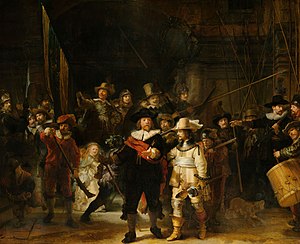

Baroque painting is the painting associated with the Baroque cultural movement. The movement is often identified with Absolutism, the Counter Reformation and Catholic Revival, but the existence of important Baroque art and architecture in non-absolutist and Protestant states throughout Western Europe underscores its widespread popularity.
Baroque painting encompasses a great range of styles, as most important and major painting during the period beginning around 1600 and continuing throughout the 17th century, and into the early 18th century is identified today as Baroque painting. In its most typical manifestations, Baroque art is characterized by great drama, rich, deep colour, and intense light and dark shadows, but the classicism of French Baroque painters like Poussin and Dutch genre painters such as Vermeer are also covered by the term, at least in English. As opposed to Renaissance art, which usually showed the moment before an event took place, Baroque artists chose the most dramatic point, the moment when the action was occurring: Michelangelo, working in the High Renaissance, shows his David composed and still before he battles Goliath; Bernini's Baroque David is caught in the act of hurling the stone at the giant. Baroque art was meant to evoke emotion and passion instead of the calm rationality that had been prized during the Renaissance.
Among the greatest painters of the Baroque period are Velázquez, Caravaggio, Rembrandt, Rubens, Poussin, and Vermeer. Caravaggio is an heir of the humanist painting of the High Renaissance. His realistic approach to the human figure, painted directly from life and dramatically spotlit against a dark background, shocked his contemporaries and opened a new chapter in the history of painting. Baroque painting often dramatizes scenes using chiaroscuro light effects; this can be seen in works by Rembrandt, Vermeer, Le Nain and La Tour. The Flemish painter Anthony van Dyck developed a graceful but imposing portrait style that was very influential, especially in England.
The prosperity of 17th century Holland led to an enormous production of art by large numbers of painters who were mostly highly specialized and painted only genre scenes, landscapes, still lifes, portraits or history paintings. Technical standards were very high, and Dutch Golden Age painting established a new repertoire of subjects that was very influential until the arrival of Modernism.
History

The Council of Trent (1545–1563), in which the Roman Catholic Church answered many questions of internal reform raised by both Protestants and by those who had remained inside the Catholic Church, addressed the representational arts in a short and somewhat oblique passage in its decrees. This was subsequently interpreted and expounded by a number of clerical authors like Molanus, who demanded that paintings and sculptures in church contexts should depict their subjects clearly and powerfully, and with decorum, without the stylistic airs of Mannerism. This return toward a populist conception of the function of ecclesiastical art is seen by many art historians as driving the innovations of Caravaggio and the Carracci brothers, all of whom were working (and competing for commissions) in Rome around 1600, although unlike the Carracci, Caravaggio persistently was criticised for lack of decorum in his work. However, although religious painting, history painting, allegories, and portraits were still considered the most noble subjects, landscape, still life, and genre scenes were also becoming more common in Catholic countries, and were the main genres in Protestant ones.
The term
The term "Baroque" was initially used with a derogatory meaning, to underline the excesses of its emphasis. Others derive it from the mnemonic term "Baroco" denoting, in logical Scholastica, a supposedly laboured form of syllogism. In particular, the term was used to describe its eccentric redundancy and noisy abundance of details, which sharply contrasted the clear and sober rationality of the Renaissance. It was first rehabilitated by the Swiss-born art historian, Heinrich Wölfflin (1864–1945) in his Renaissance und Barock (1888); Wölfflin identified the Baroque as "movement imported into mass", an art antithetic to Renaissance art. He did not make the distinctions between Mannerism and Baroque that modern writers do, and he ignored the later phase, the academic Baroque that lasted into the 18th century. Writers in French and English did not begin to treat Baroque as a respectable study until Wölfflin's influence had made German scholarship pre-eminent.
National variations
Led by Italian Baroque painting, Mediterranean countries, slowly followed by most of the Holy Roman Empire in Germany and Central Europe, generally adopted a full-blooded Baroque approach.
A rather different art developed out of northern realist traditions in 17th century Dutch Golden Age painting, which had very little religious art, and little history painting, instead playing a crucial part in developing secular genres such as still life, genre paintings of everyday scenes, and landscape painting. While the Baroque nature of Rembrandt's art is clear, the label is less used for Vermeer and many other Dutch artists. Most Dutch art lacks the idealization and love of splendour typical of much Baroque work, including the neighbouring Flemish Baroque painting which shared a part in Dutch trends, while also continuing to produce the traditional categories in a more clearly Baroque style.
In France a dignified and graceful classicism gave a distinctive flavour to Baroque painting, where the later 17th century is also regarded as a golden age for painting. Two of the most important artists, Nicolas Poussin and Claude Lorrain, remained based in Rome, where their work, almost all in easel paintings, was much appreciated by Italian as well as French patrons.
Baroque painters
 Jacob Isaakszoon van Ruisdael, Bentheim Castle (1653).
Jacob Isaakszoon van Ruisdael, Bentheim Castle (1653).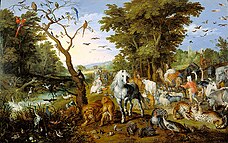 Jan Brueghel the Elder, The Entry of the Animals Into Noah's Ark, 1613.
Jan Brueghel the Elder, The Entry of the Animals Into Noah's Ark, 1613.
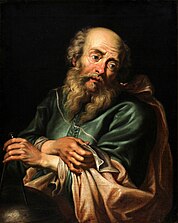 Peter Paul Rubens, Galileo Galilei, c. 1630
Peter Paul Rubens, Galileo Galilei, c. 1630 Georges de La Tour, Joseph the Carpenter, 1642, Louvre
Georges de La Tour, Joseph the Carpenter, 1642, Louvre Francisco de Zurbarán, The Birth of the Virgin, c. 1625–1630
Francisco de Zurbarán, The Birth of the Virgin, c. 1625–1630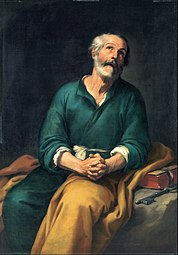 Bartolomé Esteban Murillo, Saint Peter in Tears, 1650–1655
Bartolomé Esteban Murillo, Saint Peter in Tears, 1650–1655 Tomás Yepes, Virgen de los desamparados (1644), a trompe-l'œil in horror vacui Baroque style
Tomás Yepes, Virgen de los desamparados (1644), a trompe-l'œil in horror vacui Baroque style
British
- William Dobson (1611–1646)
- George Jamesone (1587–1644)
- Godfrey Kneller (1646–1723)
- Peter Lely (1618–1680)
- Daniël Mijtens (1590–1648)
- John Michael Wright (1617–1694)
Dutch
- Rembrandt (1606–1669)
- Hendrick Avercamp (1585–1634)
- Gerard ter Borch (1617–1681)
- Adriaen Brouwer (1605–1638)
- Hendrick ter Brugghen (1588-1629)
- Aelbert Cuyp (1620–1691)
- Gerrit Dou (1613–1675)
- Jan van Goyen (1596–1656)
- Frans Hals (1580–1666)
- Meindert Hobbema (1638–1709)
- Gerard van Honthorst (1592–1656)
- Pieter de Hooch (1629–1684)
- Willem Kalf (1619–1693)
- Pieter van Laer (1599–1642)
- Judith Leyster (1609–1660)
- Gabriël Metsu (1629–1667)
- Adriaen van Ostade (1610–1685)
- Jacob van Ruisdael (1628–1682)
- Salomon van Ruysdael (1602–1670)
- Pieter Jansz. Saenredam (1597–1665)
- Johannes Vermeer (1632–1675)
- Jan Steen (1626–1679)
Czech (Bohemian)
- Václav Hollar (1607–1677)
- Karel Škréta (1610–1674)
- Petr Brandl (1668–1735)
- Václav Vavřinec Reiner (1686–1743)
Flemish
- Peter Paul Rubens (1577–1640)
- Anthony van Dyck (1599–1641)
- Jacob Jordaens (1593–1678)
- Jan Brueghel the Elder (1568–1625)
- Frans Francken the Younger (1581–1642)
- Clara Peeters (1594–1657)
- Gerard Seghers (1591–1651)
- Frans Snyders (1579–1657)
- David Teniers the Younger (1610–1691)
- Adriaen van Utrecht (1599–1652)
- Cornelis de Vos (1584–1651)
French
- Valentin de Boulogne (1591–1632)
- Philippe de Champaigne (1602–1674)
- Laurent de La Hyre (1606–1656)
- Georges de La Tour (1593–1652)
- Charles Le Brun (1619–1690)
- Le Nain brothers :
- Antoine Le Nain (c. 1599–1648)
- Louis Le Nain (c. 1593–1648)
- Mathieu Le Nain (1607–1677)
- Eustache Le Sueur (1617–1655)
- Claude Lorrain (1600–1682)
- Pierre Mignard (1612–1695)
- Hyacinthe Rigaud (1659–1743)
- Nicolas Poussin (1594–1665)
- Simon Vouet (1590–1649)
- Antoine Watteau (1684–1721)
- François Boucher (1703–1770)
- Jean-Honoré Fragonard (1732–1806)
German
- Cosmas Damian Asam (1686–1739)
- Wolfgang Heimbach (1605-1678)
- Adam Elsheimer (1578–1610)
- Johann Liss (1590–1627)
- Sebastian Stoskopff (1597–1657)
Hungarian
- Ádám Mányoki (1673–1757)
Italian
- Federico Barocci (1535–1612)
- Jacopo Chimenti (1554–1640)
- Giovanni Battista Paggi (1554–1627)
- Antonio Tempesta (1555–1630)
- Bartolomeo Cesi (1556–1629)
- Alessandro Maganza (1556–1640)
- Bernardo Castello (1557–1629)
- Lodovico Cigoli (1559–1613)
- Enea Talpino (1559–1626)
- Bartolommeo Carducci (1560–1610)
- Caravaggio (1571–1610)
- Guercino (1591–1666)
- Annibale Carracci (1560–1609)
- Guido Reni (1575–1642)
- Giuseppe Passeri (1654-1714)
- Orazio Gentileschi (1563–1639)
- Artemisia Gentileschi (1592– c. 1656)
- Domenichino (1581–1641)
- Agostino Carracci (1557–1602)
- Ludovico Carracci (1555–1619)
- Bernardo Strozzi (1581-1644)
- Pietro da Cortona (1596–1669)
- Giovanna Garzoni (1600-1670)
- Virginia Vezzi (1601-1638)
- Gregorio Preti (1603–1672)
- Francesco Cozza (1605–1682)
- Mattia Preti (1613–1699)
- Salvator Rosa (1615–1673)
- Luca Giordano (1634-1705)
- Elisabetta Sirani (1638-1665)
- Andrea Pozzo (1642–1709)
Polish
- pl:Jan Reisner (1655–1713)
- Jerzy Siemiginowski-Eleuter (1660–1711)
- Szymon Czechowicz (1689–1775)
- Bartlomiej Strobel (1591–1650)
- Krzysztof Boguszewski (1635)
Portuguese
- Josefa de Óbidos (1630–1684)
Spanish
- José Antolínez (1635–1675)
- Alonso Cano (1601–1667)
- Juan Carreño de Miranda (1614–1685)
- Claudio Coello (1642–1693)
- Juan van der Hamen (1596–1631)
- Juan Bautista Maíno (1569–1649)
- Juan Bautista Martínez del Mazo (1612–1667)
- Bartolomé Esteban Murillo (1617–1682)
- Antonio de Pereda (1611–1678)
- Lorenzo Quiros (1717 – 1789)
- Francisco Pacheco (1564–1644)
- Francisco Ribalta (1565–1628)
- José de Ribera, Lo Spagnoletto (1591–1652)
- Juan de Valdés Leal (1622–1690)
- Diego Velázquez (1599–1660)
- Tomás Yepes (1595 or 1600 – 1674)
- Francisco Zurbarán (1598–1664)
Gallery
Main articles: Baroque, Quadratura, and Flemish Baroque painting-
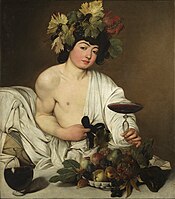 Caravaggio, Bacchus, c. 1595, Oil on canvas, 95 x 85 cm., Galleria degli Uffizi, Florence
Caravaggio, Bacchus, c. 1595, Oil on canvas, 95 x 85 cm., Galleria degli Uffizi, Florence
-
 Artemisia Gentileschi, Judith Slaying Holofernes, 1614–20, oil on canvas, 199 x 162 cm Galleria degli Uffizi, Florence
Artemisia Gentileschi, Judith Slaying Holofernes, 1614–20, oil on canvas, 199 x 162 cm Galleria degli Uffizi, Florence
-
 Frans Hals Gypsy Girl, 1628–30, oil on wood, 58 x 52 cm., Musée du Louvre, Paris
Frans Hals Gypsy Girl, 1628–30, oil on wood, 58 x 52 cm., Musée du Louvre, Paris
-
 Peter Paul Rubens, Judgement of Paris, c. 1636, National Gallery, London
Peter Paul Rubens, Judgement of Paris, c. 1636, National Gallery, London
-
 Nicolas Poussin, The Rape of the Sabine Women, 1637–38, Louvre, Paris
Nicolas Poussin, The Rape of the Sabine Women, 1637–38, Louvre, Paris
-
 José de Ribera, Martyrdom of St Philip, 1639, Prado, Madrid
José de Ribera, Martyrdom of St Philip, 1639, Prado, Madrid
-
 Salvator Rosa, Philosophy, Of Silence and Speech, Silence is better, 1640, National Gallery, London
Salvator Rosa, Philosophy, Of Silence and Speech, Silence is better, 1640, National Gallery, London
-
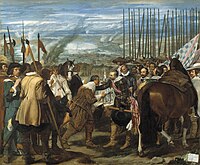 Diego Velázquez, The Surrender of Breda, 1635, oil on canvas, Museo del Prado, Madrid
Diego Velázquez, The Surrender of Breda, 1635, oil on canvas, Museo del Prado, Madrid
-
 Claude Lorrain, The Embarkation of the Queen of Sheba, 1648, 149 × 194 cm., National Gallery, London
Claude Lorrain, The Embarkation of the Queen of Sheba, 1648, 149 × 194 cm., National Gallery, London
-
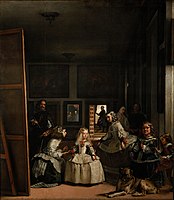 Diego Velázquez, Las Meninas, 1656–57, oil on canvas, 318 x 276 cm, Museo del Prado, Madrid
Diego Velázquez, Las Meninas, 1656–57, oil on canvas, 318 x 276 cm, Museo del Prado, Madrid
-
 Rembrandt van Rijn, The Syndics of the Clothmaker's Guild, 1662, oil on canvas, 191.5 cm × 279 cm (75.4 in × 109.8 in), Rijksmuseum, Amsterdam
Rembrandt van Rijn, The Syndics of the Clothmaker's Guild, 1662, oil on canvas, 191.5 cm × 279 cm (75.4 in × 109.8 in), Rijksmuseum, Amsterdam
-
 Jan Vermeer, The Allegory of Painting or The Art of Painting, 1666–67, 130 x 110 cm., Kunsthistorisches Museum, Vienna
Jan Vermeer, The Allegory of Painting or The Art of Painting, 1666–67, 130 x 110 cm., Kunsthistorisches Museum, Vienna
See also
References
- Counter Reformation, from Encyclopædia Britannica Online, latest edition, full-article.
- Counter Reformation Archived 2008-12-11 at the Wayback Machine, from The Columbia Encyclopedia, Sixth Edition. 2001–05.
- Helen Gardner, Fred S. Kleiner, and Christin J. Mamiya, "Gardner's Art Through the Ages" (Belmont, California: Thomson/Wadsworth, 2005)
- For example, in French calling Poussin Baroque would be generally rejected
- "Getty profile, including variant spellings of the artist's name". Getty.edu. 2002-12-11. Retrieved 2012-02-13.
- Gombrich, p. 420.
- Belkin (1998): 11–18.
- His Lives of the Painters was published in Rome, 1672. Poussin's other contemporary biographer was André Félibien.
- W. Liedtke (2007) Dutch Paintings in the Metropolitan Museum of Art, p. 867.
- Panofsky, Erwin (1995). "What is Baroque?". Three Essays on Style. The MIT Press: 19.
- Often described as Saint Bartholemew, martyred in similar fashion, but now recognized as St Philip. See Museo del Prado, Catálogo de las pinturas, 1996, p. 315, Ministerio de Educación y Cultura, Madrid, No ISBN.
Reading
- Belkin, Kristin Lohse (1998). Rubens. Phaidon Press. ISBN 0-7148-3412-2.
- Belting, Hans (1994). Likeness and Presence: A History of the Image before the Era of Art. Edmund Jephcott. University of Chicago Press. ISBN 0-226-04215-4.
- Mark Getlein, Living With Art, 8th edition.
- Gombrich, E.H., The Story of Art, Phaidon, 1995. ISBN 0-7148-3355-X
- Christine Buci-Glucksmann, Baroque Reason: The Aesthetics of Modernity, Sage, 1994
- Michael Kitson, 1966. The Age of Baroque'
- Heinrich Wölfflin, 1964. Renaissance and Baroque (Reprinted 1984; originally published in German, 1888) The classic study. ISBN 0-8014-9046-4